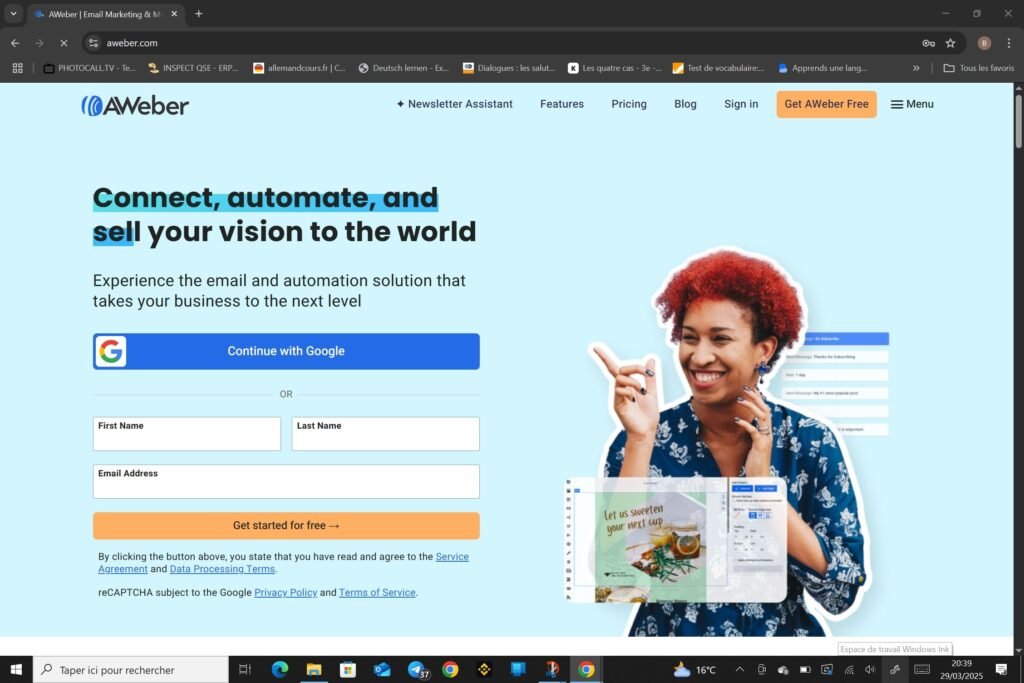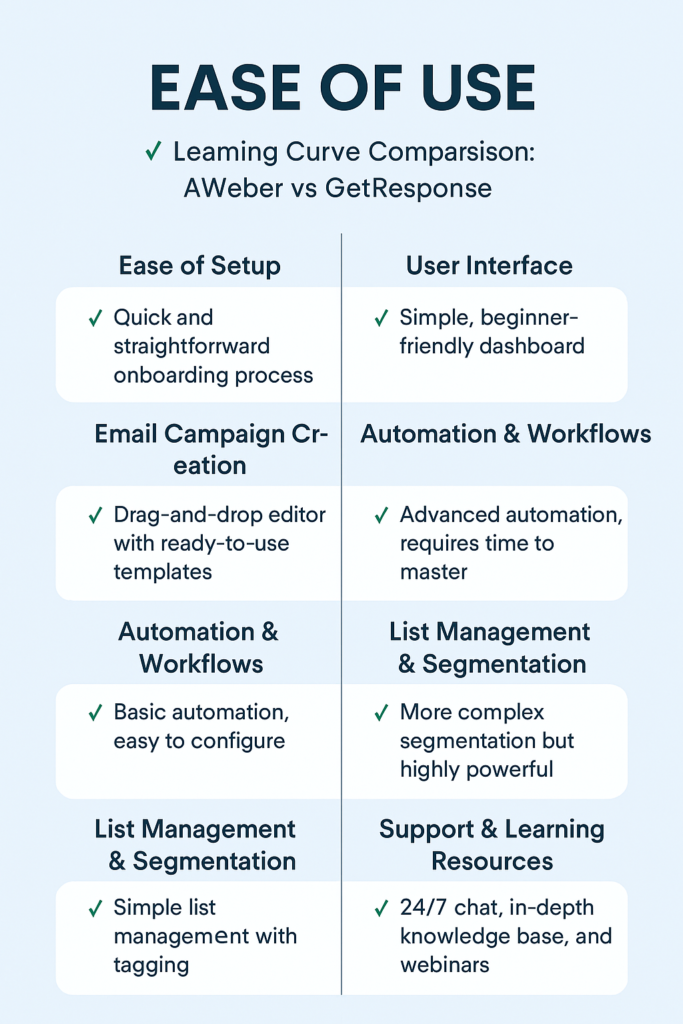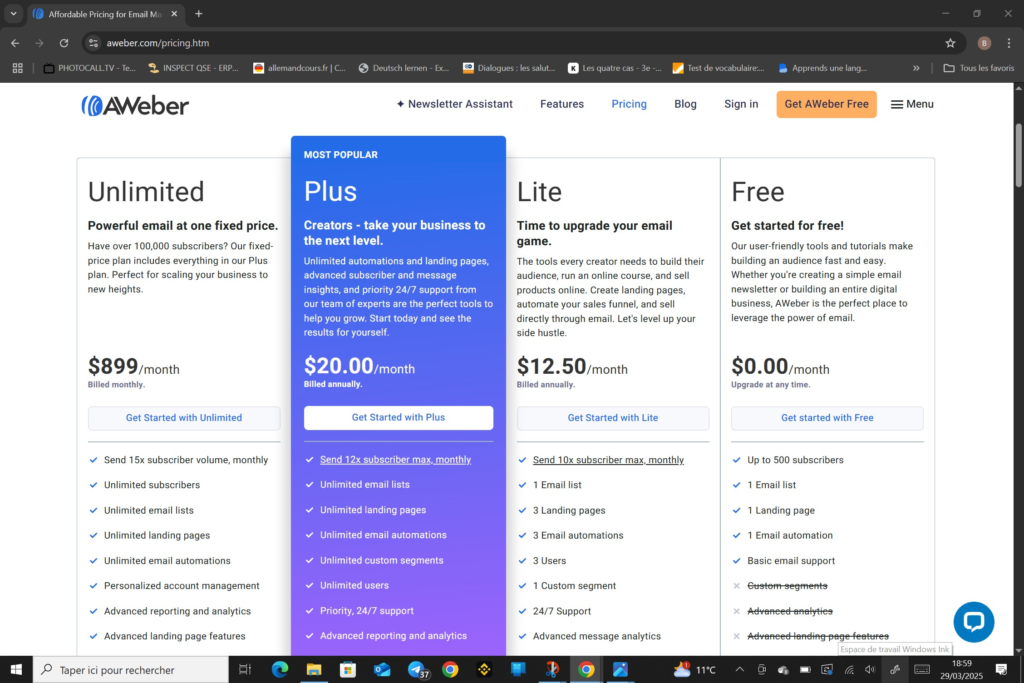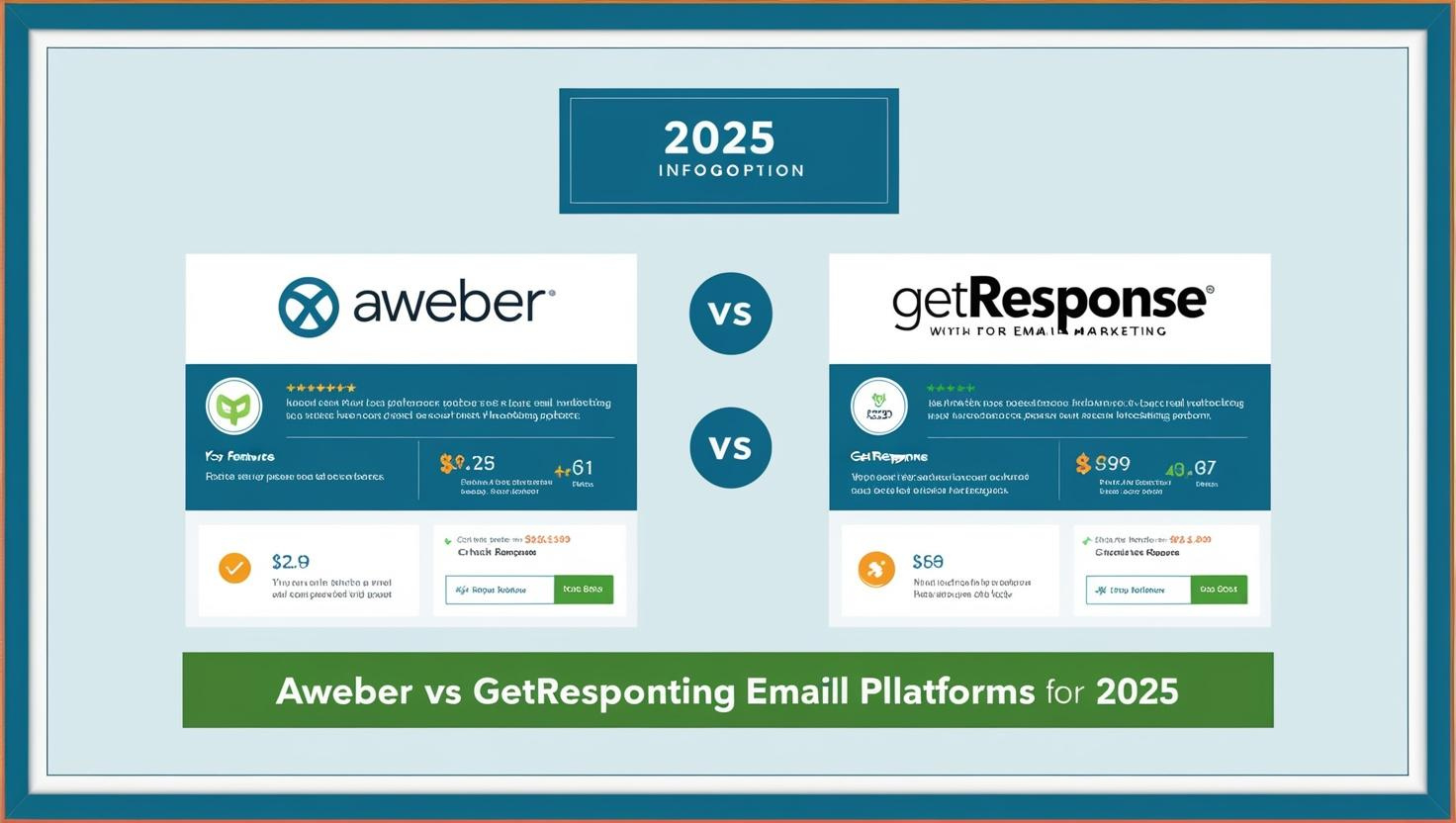Table des matières
Choosing the right email marketing platform can make a huge difference in your business growth. With so many options available, two of the most popular choices are AWeber and GetResponse. Both tools offer powerful features for email automation, landing pages, and list management—but which one is the best for your needs?
In this AWeber vs GetResponse comparison, we’ll break down their features, pricing, automation capabilities, and more. By the end of this guide, you’ll have a clear understanding of which platform is the right fit for your business.

2. Ease of Use
When comparing AWeber vs GetResponse, ease of use is a crucial factor, especially for beginners and small business owners who want a smooth email marketing experience.
Dashboard & User Interface
Both AWeber and GetResponse offer clean, intuitive dashboards, but they differ in layout and navigation.
- AWeber has a straightforward interface with a classic menu structure. The dashboard is simple, making it easy to access campaigns, lists, and reports. However, it may feel slightly outdated compared to more modern platforms.
- GetResponse provides a more visually appealing and modern dashboard with a well-organized sidebar menu. Features like automation workflows, landing pages, and analytics are easily accessible.


Campaign Creation & Email Editor
Both platforms offer drag-and-drop editors for email creation, but GetResponse provides a smoother experience.
- AWeber has a simple drag-and-drop builder with essential customization features. It works well but can feel slightly rigid compared to other tools.
- GetResponse offers a more advanced and flexible email editor, allowing better customization with pre-designed blocks and an improved drag-and-drop experience.
Learning Curve
- AWeber is ideal for beginners due to its no-frills interface and guided setup process.
- GetResponse has more advanced features, which can take slightly longer to master, but it provides interactive tutorials and tooltips to help users get started quickly.

When it comes to ease of use, AWeber is better for absolute beginners due to its simplicity, while GetResponse offers a more modern interface and smoother navigation, making it a better choice for users who want more advanced features without a steep learning curve
3. Email Templates & Customization
One of the most important factors when choosing between AWeber vs GetResponse is the variety and flexibility of email templates. A well-designed email can improve engagement, boost conversions, and create a professional brand image. Let’s compare how both platforms perform in this area.
Number and Variety of Email Templates
Both AWeber and GetResponse offer pre-designed email templates to help users create visually appealing emails quickly.
- AWeber provides over 600 email templates, making it one of the largest template libraries in the industry. However, some designs feel slightly outdated.
- GetResponse offers around 200 modern templates, but they are better optimized for mobile devices and visually more appealing.
Drag-and-Drop Email Editor
Both platforms feature drag-and-drop editors, allowing users to customize emails without coding.
- AWeber has a basic editor that allows easy text, image, and button placement. However, customization options are somewhat limited compared to GetResponse.
- GetResponse offers a more advanced editor with greater flexibility. Users can create fully responsive emails with customizable sections, fonts, and dynamic content blocks.
Mobile Responsiveness & Customization
- AWeber ensures that emails are mobile-friendly but offers fewer customization options for mobile-specific designs.
- GetResponse allows users to preview emails on different devices and adjust layouts specifically for mobile users, ensuring a better user experience.
Verdict
When comparing AWeber vs GetResponse for email templates and customization, AWeber offers more template choices, but GetResponse provides better modern designs and customization flexibility. If you prioritize quantity, AWeber is the better option, but if you need more customization and mobile optimization, GetResponse is the stronger choice.
4. Automation & Autoresponders
When choosing between AWeber vs GetResponse, automation features play a key role, especially for businesses looking to streamline email campaigns and customer engagement. Both platforms offer autoresponders and advanced automation, but they differ in functionality and ease of use.
Autoresponders: AWeber vs GetResponse
Autoresponders allow you to send automated email sequences based on user actions, such as signing up for a newsletter or making a purchase.
- AWeber has a simple autoresponder feature that lets users schedule a sequence of emails based on time delays. While effective, it lacks advanced behavioral triggers.
- GetResponse offers a more advanced autoresponder system, allowing users to send emails based on specific actions, such as link clicks, product purchases, or abandoned carts.
| Feature | AWeber ✅ | GetResponse ✅ |
|---|
| Basic Autoresponders | ✅ Yes | ✅ Yes |
| Drag-and-Drop Workflow Builder | ❌ No | ✅ Yes |
| Time-Based Sequences | ✅ Yes | ✅ Yes |
| Behavior-Based Automation | ❌ Limited | ✅ Advanced (tags, actions) |
| Custom Triggers | ❌ Basic (Sign-up, Opens) | ✅ Yes (Clicks, Purchases, etc.) |
| A/B Testing for Sequences | ❌ No | ✅ Yes |
| Advanced Segmentation | ❌ Limited | ✅ Yes (Dynamic segmentation) |
| Pre-built Automation Templates | ✅ Yes | ✅ Yes |
| E-commerce Triggers | ❌ No | ✅ Yes (Abandoned carts, purchases) |
| Webinar Integration | ❌ No | ✅ Yes (Automated webinar sequences) |
Automation Workflows & Triggers
Automation workflows help businesses create targeted email sequences based on customer behavior.
- AWeber provides basic automation, allowing users to send emails after specific triggers, such as a user joining a list. However, it lacks advanced segmentation and conditional logic.
- GetResponse has a visual workflow builder that enables users to design complex automation sequences using multiple triggers, actions, and conditions. This makes it more powerful for advanced email marketing strategies.
Segmentation & Personalization
Both platforms allow you to segment your audience for better-targeted emails.
- AWeber offers list-based segmentation, meaning you can create different lists and send emails accordingly. However, moving subscribers between lists can be tricky.
- GetResponse provides dynamic segmentation, allowing users to apply tags and move subscribers through different automation paths based on their actions.

In the AWeber vs GetResponse automation comparison, AWeber is suitable for users who need simple, time-based autoresponders, while GetResponse is the better choice for businesses looking for advanced automation with behavioral triggers and workflow customization. If automation is a priority, GetResponse is the clear winner.
5. Email Deliverability Rates
When comparing AWeber vs GetResponse, one of the most important factors to consider is email deliverability rates. A high deliverability rate ensures that your emails reach your subscribers’ inboxes instead of landing in spam folders. Let’s see how AWeber and GetResponse perform in this area.
Deliverability Performance: AWeber vs GetResponse
Both platforms have strong reputations for high email deliverability, but there are some differences:
- AWeber consistently maintains a deliverability rate of around 85-98%, thanks to its strong email authentication and reputation with ISPs.
- GetResponse also boasts a high deliverability rate of around 85-97%, using similar authentication methods and anti-spam policies.
Spam Compliance & Email Authentication
Both services use authentication protocols to ensure emails reach inboxes:
- AWeber uses DKIM, SPF, and DMARC authentication, which help verify emails and prevent them from being flagged as spam.
- GetResponse also implements SPF and DKIM authentication, improving sender credibility.
Inbox Placement & Avoiding Spam Filters
Inbox placement is just as important as deliverability.
- AWeber has strict anti-spam policies, meaning emails are less likely to be marked as spam. However, this also means stricter content filtering.
- GetResponse offers list hygiene tools and AI-based spam detection, helping improve inbox placement
In the AWeber vs GetResponse deliverability comparison, both platforms perform well, with AWeber slightly ahead in spam compliance and GetResponse excelling in inbox placement and list hygiene tools. If deliverability is your top priority, AWeber has a slight edge, but GetResponse remains a strong competitor.
6. List Management & Segmentation
Effective email marketing relies on how well you manage and segment your subscribers. In this AWeber vs GetResponse comparison, we’ll look at how both platforms handle list management, tagging, and segmentation to help you send more targeted and personalized emails.
Managing Email Lists: AWeber vs GetResponse
Both platforms allow you to import, manage, and organize email lists, but they take different approaches.
- AWeber follows a list-based approach, meaning each list is separate. If a subscriber is on multiple lists, they count as multiple contacts, which can increase costs.
- GetResponse offers a tag-based system, allowing you to manage subscribers within a single list and apply tags to organize them based on behavior or interests. This is more flexible and prevents duplicate contacts.
Segmentation Features
Segmentation is crucial for sending personalized emails. Here’s how both platforms handle it:
- AWeber provides basic segmentation, allowing you to segment subscribers based on sign-up forms, tags, and engagement (opens, clicks). However, segmentation options are somewhat limited compared to GetResponse.
- GetResponse offers advanced segmentation, allowing users to filter contacts by behavior, location, purchase history, and even engagement levels. You can also create dynamic segments that update automatically.
Automation & List Cleaning
- AWeber allows manual list cleaning, but automation is limited. You must remove inactive subscribers manually.
- GetResponse includes list hygiene automation, automatically removing inactive or unengaged subscribers to keep your list healthy.
In the AWeber vs GetResponse battle for list management and segmentation, GetResponse is the better choice for advanced segmentation and automation. AWeber works well for simple list management, but if you need detailed targeting and dynamic segmentation, GetResponse is the winner.
7. Landing Pages & Forms
A well-designed landing page and sign-up form can significantly impact lead generation and conversion rates. In this AWeber vs GetResponse comparison, we’ll evaluate how both platforms perform in terms of landing page builders, form customization, and lead capture tools.
Landing Page Builder: AWeber vs GetResponse
Both AWeber and GetResponse provide built-in landing page builders, but there are key differences in functionality.
- AWeber offers a basic landing page builder with a drag-and-drop editor. It includes pre-designed templates, but customization options are somewhat limited.
- GetResponse has a more advanced landing page builder, featuring over 200 mobile-responsive templates, A/B testing, and built-in analytics for tracking conversions. It also integrates seamlessly with Facebook Ads and Google Ads.
Form Creation & Customization
Sign-up forms are essential for capturing leads. Let’s see how both platforms handle form creation:
- AWeber provides basic sign-up forms that can be embedded on websites or used as standalone pages. Customization options include color, font, and layout changes.
- GetResponse offers more flexibility with pop-ups, exit-intent forms, and embeddable forms. It also allows deeper form customization with conditional logic for personalized lead capture.
Integration & Lead Capture Tools
- AWeber allows integration with third-party tools like WordPress, Shopify, and Wix for embedding forms. However, it lacks built-in advanced targeting.
- GetResponse includes lead magnets, Facebook pixel tracking, and behavioral targeting, making it more effective for conversion optimization.
Verdict
In the AWeber vs GetResponse comparison for landing pages and forms, GetResponse is the clear winner due to its advanced landing page builder, better customization options, and superior lead capture tools. AWeber is a good option for simple forms, but if you need high-converting landing pages, GetResponse is the better choice.
8. Integrations & Third-Party Tools
The ability to integrate with other tools is essential for any email marketing platform. In this AWeber vs GetResponse comparison, we’ll explore how both services connect with third-party apps to enhance your marketing efforts.
Number of Integrations: AWeber vs GetResponse
Both AWeber and GetResponse support a wide range of integrations, including eCommerce platforms, CRM systems, webinar tools, and social media apps.
- AWeber integrates with over 750 third-party applications, including Shopify, WordPress, PayPal, and Zapier.
- GetResponse supports over 150 integrations, including eCommerce tools like WooCommerce and Shopify, CRM systems like Salesforce, and automation tools like Zapier.
| Integration Type | AWeber ✅ | GetResponse ✅ |
|---|
| Total Number of Integrations | 🔗 750+ | 🔗 150+ |
| E-commerce (Shopify, WooCommerce, Magento, etc.) | ✅ Yes | ✅ Yes |
| CRM Tools (HubSpot, Salesforce, Pipedrive, etc.) | ✅ Yes | ✅ Yes |
| Payment Processors (Stripe, PayPal, Square, etc.) | ✅ Yes | ✅ Yes |
| Social Media & Ads (Facebook, Instagram, LinkedIn, etc.) | ✅ Yes | ✅ Yes |
| Webinars & Events (Zoom, Eventbrite, Calendly, etc.) | ❌ No | ✅ Yes |
| Automation Tools (Zapier, Make, Integrately, etc.) | ✅ Yes | ✅ Yes |
| Customer Support (LiveChat, Zendesk, Intercom, etc.) | ✅ Yes | ✅ Yes |
| Landing Page Builders (Unbounce, ClickFunnels, etc.) | ✅ Yes | ✅ Yes |
| Analytics & Reporting (Google Analytics, Hotjar, etc.) | ✅ Yes | ✅ Yes |
eCommerce & Payment Gateway Integrations
For businesses selling online, seamless eCommerce integrations are a must.
- AWeber works well with major eCommerce platforms like Shopify, WooCommerce, and BigCommerce. However, direct payment gateway integrations are limited.
- GetResponse provides deeper eCommerce integrations, including Shopify, Magento, and direct payment solutions like PayPal and Stripe. It also offers abandoned cart recovery emails, which AWeber lacks.
Webinar & CRM Integrations
- AWeber integrates with basic CRM tools like Salesforce and Pipedrive, but lacks built-in webinar support.
- GetResponse has a built-in webinar feature, eliminating the need for third-party webinar software, plus strong CRM integrations with HubSpot and Salesforce.
Automation & Zapier Connectivity
Both platforms support Zapier, allowing users to connect with thousands of other apps.
- AWeber relies more on Zapier for extended integrations.
- GetResponse offers native integrations for automation tools, reducing reliance on third-party connectors.
| tegration Type | AWeber via Zapier ✅ | GetResponse via Zapier ✅ |
|---|
| Google Sheets (Sync new subscribers) | ✅ Yes | ✅ Yes |
| Facebook Leads Ads (Add new leads to email lists) | ✅ Yes | ✅ Yes |
| Shopify & WooCommerce (Sync customers for email automation) | ✅ Yes | ✅ Yes |
| Calendly & Eventbrite (Trigger emails for new event sign-ups) | ✅ Yes | ✅ Yes |
| Slack & Teams (Send notifications for new subscribers) | ✅ Yes | ✅ Yes |
| CRM tools (HubSpot, Salesforce, Pipedrive) | ✅ Yes | ✅ Yes |
| Google Forms & Typeform (Add form responses to email lists) | ✅ Yes | ✅ Yes |
| Stripe & PayPal (Trigger emails after purchases) | ✅ Yes | ✅ Yes |
| E-commerce Triggers (Abandoned Cart Emails) | ❌ Limited | ✅ More advanced |
| Custom Multi-Step Workflows | ✅ Yes | ✅ Yes |
Verdict
In the AWeber vs GetResponse integrations comparison, AWeber wins in terms of quantity, while GetResponse provides deeper native integrations and built-in webinar support. If you need a larger range of third-party connections, AWeber is better, but for advanced marketing automation, GetResponse is the stronger choice.
9. Pricing & Plans
Pricing is a key factor when choosing between AWeber vs GetResponse, as both platforms offer different plans based on features and subscriber count. Let’s compare their pricing structures to see which one offers better value.
AWeber vs GetResponse: Free Plans
Both AWeber and GetResponse offer free plans with limited features:
- AWeber Free Plan – Supports up to 500 subscribers, allows basic email automation, and includes landing pages. However, it lacks advanced automation and segmentation.
- GetResponse Free Plan – Supports up to 500 contacts, includes unlimited newsletters, landing pages, and one sales funnel, but lacks automation.
| Feature | AWeber Free Plan | GetResponse Free Plan |
|---|---|---|
| Subscriber Limit | Up to 500 subscribers | Up to 500 contacts |
| Emails per Month | Unlimited | Unlimited |
| Automation | ❌ Not included | ❌ Basic autoresponder only |
| Landing Pages | ✅ Limited templates | ✅ Basic landing pages |
| Signup Forms | ✅ Available | ✅ Available |
| E-commerce Features | ❌ Not included | ✅ Available (limited) |
| Webinars | ❌ Not included | ❌ Not included |
| A/B Testing | ❌ Not included | ❌ Not included |
| Integrations | ✅ Available (Limited) | ✅ Available (Limited) |
| Support | ✅ 24/7 chat & email support | ❌ Limited to knowledge base |
📌 Key Takeaways:
Neither free plan includes automation or A/B testing.
AWeber’s free plan includes better customer support (24/7 chat & email).
GetResponse’s free plan has basic e-commerce tools but limited support.
Both plans support landing pages, signup forms, and integrations.
Paid Plans & Pricing Tiers
Both platforms have tiered pricing based on the number of subscribers.
AWeber Pricing (Monthly):
- Lite Plan: $12.50/month – Includes basic email automation and templates.
- Plus Plan: $20/month – Adds split testing, behavioral automation, and more templates.
- Unlimited Plan: $899/month – For large-scale businesses needing custom features.

GetResponse Pricing (Monthly):
- Email Marketing Plan: Starts at $19/month – Includes email automation, landing pages, and segmentation.
- Marketing Automation Plan: Starts at $59/month – Adds advanced automation, webinars, and eCommerce features.
- Ecommerce Marketing Plan: Starts at $119/month – Includes eCommerce automation and transactional emails.

Which Platform Offers Better Value?
- AWeber is better for small businesses that need simple email marketing tools without complex automation.
- GetResponse offers better value for growing businesses that need advanced automation, webinars, and eCommerce features
In the AWeber vs GetResponse pricing comparison, AWeber is the better budget-friendly option, while GetResponse provides more features for scaling businesses. If you need advanced automation and webinar tools, GetResponse is worth the extra cost.
10. Customer Support & Resources
Good customer support is essential when choosing between AWeber vs GetResponse, especially if you need quick assistance with email marketing campaigns. Let’s compare how both platforms perform in terms of support availability, response time, and learning resources.
Support Channels: AWeber vs GetResponse
Both AWeber and GetResponse offer multiple support options, but they differ in availability and accessibility.
- AWeber provides 24/7 live chat and email support, along with phone support during business hours (Monday–Friday). This makes it a strong option for users who prefer direct assistance.
- GetResponse offers 24/7 live chat support but no phone support. However, higher-tier plans include dedicated account managers for personalized assistance.
| Support Option | AWeber | GetResponse |
|---|---|---|
| Live Chat | ✅ 24/7 | ✅ 24/7 |
| Email Support | ✅ 24/7 | ✅ 24/7 |
| Phone Support | ✅ (Business Hours, Mon–Fri) | ❌ Not Available |
| Dedicated Account Manager | ❌ (Not Available) | ✅ (For higher-tier plans) |
| Knowledge Base & Tutorials | ✅ Extensive guides & videos | ✅ Step-by-step guides & webinars |
Key Takeaways:
- AWeber offers phone support, making it ideal for those who prefer direct assistance.
- GetResponse provides dedicated account managers, but only for premium users.
- Both platforms have 24/7 live chat and email support, ensuring quick help when needed.
Would you like any modifications or additional comparisons? 😊
Response Time & Quality of Support
- AWeber is known for fast response times, with live chat typically responding within minutes and email queries answered within a few hours.
- GetResponse also offers quick live chat responses, but email support may take longer depending on the plan.
| Support Type | AWeber Response Time | GetResponse Response Time |
|---|---|---|
| Live Chat | ⏳ ~5 minutes | ⏳ ~5 minutes |
| Email Support | ⏳ 2–3 hours | ⏳ 3–5 hours |
| Phone Support | 📞 Instant (during business hours) | ❌ Not Available |
| Dedicated Account Manager | ❌ Not Available | 🕒 Varies (priority support for premium plans) |
Key Insights:
GetResponse provides priority support for premium users via dedicated account managers..
Live chat is fast on both platforms (~5 minutes).
AWeber has quicker email support, typically responding within 2–3 hours.
AWeber offers phone support, while GetResponse doesn’t.
Knowledge Base & Learning Resources
Both platforms provide extensive resources to help users improve their email marketing strategies.
- AWeber offers a detailed knowledge base, video tutorials, and free live webinars. It also has a blog with practical email marketing tips.
- GetResponse includes a comprehensive help center, step-by-step guides, and an email marketing certification program for users who want in-depth training.
Verdict
In the AWeber vs GetResponse customer support comparison:
- AWeber wins for faster response times and phone support.
- GetResponse excels in educational resources and dedicated account managers for high-tier users.
If direct and fast customer support is a priority, AWeber is the better choice. However, if you prefer in-depth learning resources and personalized guidance, GetResponse has the edge.
11. Pros & Cons of AWeber vs GetResponse
When choosing between AWeber vs GetResponse, understanding the strengths and weaknesses of each platform can help you make an informed decision. Below, we break down the pros and cons of both services to highlight their key differences.
Pros & Cons of AWeber
✅ Pros:
- User-friendly interface – Simple and easy to use, even for beginners.
- 24/7 live chat & phone support – Provides fast and reliable customer assistance.
- Strong email deliverability – Ensures emails reach inboxes rather than spam folders.
- Extensive integrations – Works with 750+ third-party apps, including WordPress and Shopify.
- Affordable pricing for small lists – The free plan supports up to 500 subscribers.
❌ Cons:
- Basic automation features – Lacks advanced automation compared to GetResponse.
- Limited landing page customization – Fewer design options for landing pages.
- Subscriber duplication – Contacts in multiple lists count as separate subscribers, increasing costs.
| Aspect | Avantages ✅ | Inconvénients ❌ |
|---|
| Facilité d’utilisation | Interface intuitive, idéale pour les débutants | Moins d’options avancées pour les experts |
| Support client | 📞 Support 24/7 (chat, email, téléphone) | Pas de gestionnaire de compte dédié |
| Tarification | Plan gratuit jusqu’à 500 abonnés | Abonnés dupliqués comptent plusieurs fois (coût plus élevé) |
| Automatisation | Automatisations de base faciles à configurer | Moins avancé que GetResponse |
| Délivrabilité | Très bon taux de délivrabilité des emails | Peu d’options pour tester et optimiser les envois |
| Templates d’emails | Large choix de modèles prêts à l’emploi | Moins de personnalisation que d’autres plateformes |
| Intégrations | 750+ intégrations avec d’autres outils | Certaines intégrations nécessitent des outils tiers |
Pros & Cons of GetResponse
✅ Pros:
- Advanced automation tools – Offers powerful workflows and behavioral triggers.
- Built-in webinar hosting – A unique feature not available in AWeber.
- More flexible segmentation – Uses tags and behavioral data for targeted emails.
- High-quality landing pages – Includes A/B testing and eCommerce integrations.
- Better list management – No duplicate contacts, making list organization more efficient.
❌ Cons:
- No phone support – Lacks direct phone assistance for customer service.
- Higher pricing for advanced features – Premium plans can be expensive.
- Fewer third-party integrations – Compared to AWeber, it supports fewer external apps.
| Aspect | Avantages ✅ | Inconvénients ❌ |
|---|
| Facilité d’utilisation | Interface moderne et intuitive 📱 | Peut être complexe pour les débutants ⚠️ |
| Automatisation | Workflows avancés et segmentation dynamique 🔥 | Nécessite du temps pour maîtriser 🕒 |
| Délivrabilité | Taux de délivrabilité élevé 📩 | Peut varier selon les campagnes 📊 |
| Landing Pages | Éditeur puissant avec tunnels de vente 🚀 | Options avancées payantes 💲 |
| Webinaires | Outil intégré (unique pour une plateforme d’email marketing) 🎥 | Inclus seulement dans les plans supérieurs 💰 |
| E-commerce | Excellente intégration avec Shopify et WooCommerce 🛍️ | Manque certaines fonctionnalités avancées |
| Support Client | 24/7 chat et email 💬 | Pas de support téléphonique 📞❌ |
| Plan Gratuit | Jusqu’à 500 contacts avec accès limité 🆓 | Moins d’options que les versions payantes |
| Tarification | Bon rapport qualité/prix pour les fonctionnalités 💵 | Plans plus chers que certains concurrents 💲 |
In the AWeber vs GetResponse pros and cons comparison:
- AWeber is ideal for beginners and small businesses that need simple email marketing and strong customer support.
- GetResponse is the better choice for advanced marketers who need automation, webinars, and in-depth segmentation.
Your choice depends on your business needs—AWeber for ease of use and affordability, GetResponse for advanced features and automation.

12. Conclusion & Final Verdict
Choosing between AWeber vs GetResponse depends on your business needs, budget, and the level of features you require for email marketing. Both platforms offer powerful tools, but they cater to different types of users.
When to Choose AWeber
AWeber is a great choice if you’re looking for:
- An easy-to-use email marketing platform with a beginner-friendly interface.
- Reliable customer support, including 24/7 live chat and phone assistance.
- Strong email deliverability rates to ensure your messages reach inboxes.
- Affordable pricing for small businesses or startups with basic automation needs.
When to Choose GetResponse
GetResponse is the better option if you need:
- Advanced automation tools to create complex email workflows.
- Built-in webinar hosting, a feature not available in AWeber.
- Powerful landing pages and segmentation to improve conversions.
- Better eCommerce integration for online stores using Shopify, WooCommerce, or Magento.
Final Verdict: AWeber vs GetResponse – Which One is Better?
If you’re a beginner or small business owner looking for a simple, budget-friendly email marketing tool, AWeber is a solid option. However, if you need more automation, segmentation, and conversion-focused features, GetResponse is the better long-term investment.
Overall, AWeber is best for ease of use and customer support, while GetResponse is best for automation and marketing growth. Choose the one that aligns with your business goals!
realiser A final comparison table summarizing the key differences between AWeber vs GetResponse.
| Caractéristique | AWeber ✅ | GetResponse ✅ |
|---|---|---|
| Facilité d’utilisation | ✔ Très simple, idéal pour débutants | ❗ Un peu plus complexe mais plus puissant |
| Support client | 📞 24/7 (chat, email, téléphone) | 💬 24/7 chat et email, pas de téléphone |
| Automatisation | ⚡ Basique (répondeurs automatiques simples) | 🔥 Avancée (workflows, segmentation dynamique) |
| Délivrabilité | 📩 Très bon taux de délivrabilité | 📩 Également très performant |
| Templates d’emails | 🎨 Nombreux modèles mais moins personnalisables | 🎨 Plus de flexibilité et de personnalisation |
| Landing pages | 🏗️ Fonctionnalités limitées | 🚀 Éditeur puissant avec tunnel de conversion |
| Webinaires | ❌ Non disponible | 🎥 Inclus dans certaines offres |
| E-commerce & intégrations | 🛍️ Compatible avec de nombreux outils | 🛍️ Meilleure intégration avec Shopify et WooCommerce |
| Plan gratuit | ✅ Jusqu’à 500 abonnés | ✅ Jusqu’à 500 contacts |
| Tarification | 💲 Abordable pour les petites entreprises | 💲 Un peu plus cher mais plus complet |



